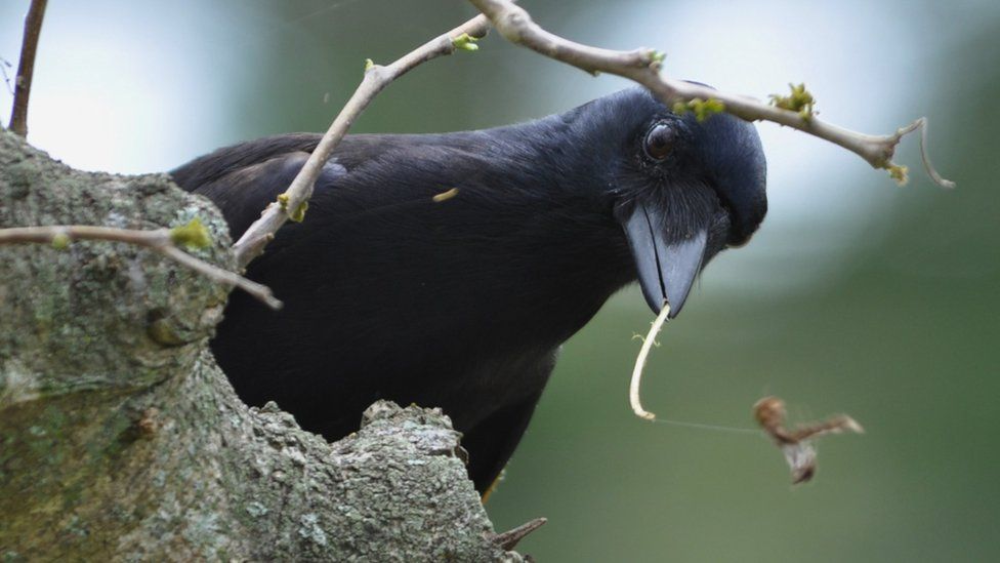Habitat and Distribution
New Caledonian crows primarily live in the forests of New Caledonia, an archipelago that consists of the main island, Grande Terre, and several smaller islands. These crows thrive in diverse habitats, ranging from coastal mangroves to dense tropical forests and mountainous regions. The rich biodiversity and relatively isolated environment of New Caledonia provide an ideal setting for these crows to develop and hone their unique skills.
Physical Characteristics
New Caledonian crows are in medium-size, with an average length of about 40 centimeters (16 inches) and a wingspan of approximately 60 centimeters (24 inches). They are predominantly black with a slightly iridescent sheen that can appear blue or green in certain lighting conditions. Their stout, slightly curved beaks are perfect for their tool-making activities.

Cognitive Abilities and Tool Use
One of the most remarkable aspects of New Caledonian crows is their sophisticated use of tools. Unlike most animals, these crows not only use tools but also manufacture and modify them to suit specific tasks. Their tool repertoire includes sticks, leaves, and even their own feathers, which they use to extract insects and other prey from hard-to-reach places like tree bark and crevices.
New Caledonian crows demonstrate a level of innovation in tool making that is unparalleled in the animal kingdom, except perhaps by humans and certain primates. They craft tools from pandanus leaves by cutting them into various shapes, including hooks and barbed spears. These tools are not randomly made; they are carefully constructed to optimize their functionality. For instance, the crows fashion hooks to pull out grubs from holes and use barbed sticks to impale insects hiding within tree bark.
Moreover, these crows exhibit the ability to use tools in a sequential manner, akin to using a toolkit. For example, they might use a shorter tool to retrieve a longer, more effective tool, demonstrating foresight and planning—a rare trait in the animal world.
Problem-Solving Skills
New Caledonian crows have consistently performed well in various problem-solving experiments. In laboratory settings, they have been observed solving complex puzzles that involve multiple steps and the use of different tools. One famous experiment, known as the “Aesop’s Fable” test, involves dropping stones into a container of water to raise the water level and access a floating treat. The crows not only passed this test but also showed a preference for using denser objects that would displace more water, indicating an understanding of cause and effect.
Social Structures and Learning
Social learning plays a crucial role in the development of tool use and other behaviors among New Caledonian crows. Young crows learn by observing their parents and other experienced individuals. This cultural transmission of knowledge ensures that effective tool-use techniques are passed down through generations.
New Caledonian crows exhibit a complex social structure, with a clear hierarchy based on age, experience, and possibly even individual intelligence. Dominant individuals often have priority access to resources, such as food and nesting sites. Social interactions, including play and cooperative behaviors, are common and contribute to the overall cohesiveness of their groups.
Communication and Language
Communication among New Caledonian crows is professional. They use a range of vocalizations and physical gestures to convey information. Vocalizations can vary from short, sharp calls to more melodious sequences, each serving different purposes, such as alerting others to danger, signaling the presence of food, or coordinating group activities.
Ecological Significance
New Caledonian crows play a vital role in their ecosystem. As both predators and scavengers, they help control insect populations and contribute to the overall health of their habitats. Their tool-using behavior can also have ecological implications, such as influencing the distribution and behavior of their prey.
Conservation Status
While New Caledonian crows are not currently considered endangered, they face several threats, including habitat loss due to logging and land development, as well as potential predation by introduced species such as rats and cats. Conservation efforts are essential to ensure the continued survival of these remarkable birds and the preservation of their unique behaviors.
Scientific Significance
The study of New Caledonian crows has profound implications for our understanding of animal cognition and the evolution of intelligence. By examining the crows’ problem-solving abilities and tool use, scientists gain insights into the cognitive processes underlying these behaviors. This research challenges the traditional view that complex cognitive abilities are unique to humans and a few other primates, suggesting instead that such traits may have evolved independently in different lineages.
Comparative studies between New Caledonian crows and other intelligent animals, such as primates and dolphins, highlight both the similarities and differences in cognitive abilities across species. These studies underscore the importance of environmental and social factors in shaping intelligence and behavior.
Conclusion
New Caledonian crows are a testament to the incredible diversity and adaptability of life on Earth. Their extraordinary cognitive abilities, particularly in tool use and problem-solving, continue to captivate and inspire researchers and laypeople alike. As we learn more about these avian geniuses, we not only gain a deeper appreciation for their unique talents but also broaden our understanding of the nature of intelligence itself. Protecting their habitats and ensuring their survival is not just a matter of ecological importance but also a crucial step in preserving a living example of cognitive evolution in the animal kingdom.









